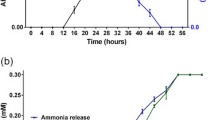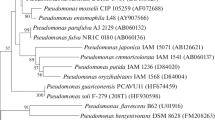Abstract
Four bacterial strains (CA26, CA28, CA37, and CA45), which all were able to use aniline, 3-chloroaniline (3-CA), and 4-chloroaniline (4-CA) as sole sources of carbon, nitrogen and energy, were isolated after enrichment in aerated soil columns and identified as Pseudomonas acidovorans strains. In addition strains CA26 and CA45 were able to degrade 2-chloroaniline (2-CA) at very low rates. At 25°C strain CA28 was grown on aniline and 3-CA with generation times of 3.0 and 7.7 h, respectively, and exhibited complete mineralization of these substrates in degradation rates of 2.25 mmol aniline and 1.63 mmol 3-CA g-1 of biomass per hour, respectively. Degradation of 4-CA occurred at 1.54 mmol 4-CA g-1 of biomass per hour and a generation time of 18.7 h but, in contrast, was not complete due to formation of minor amounts of chlorohydroxymuconic semialdehyde, a meta-cleavage product of 4-chlorocatechol. The initial attack on the substrate, the formation of corresponding chlorocatechols from 3-CA and 4-CA, was found to be the rate-limiting degradation step. Evidence for two different aniline-oxygenase systems in strain CA28 with distinct activity pattern on chlorinated and nonsubstituted anilines was demonstrated by oxygen uptake rate experiments with aniline and chloroaniline pregrown cells. Further degradation was shown to be initialized by catechol dioxygenases.
Similar content being viewed by others
Abbreviations
- CA:
-
chloroaniline
- DCA:
-
dichloroaniline
- ECM:
-
enrichment and cultivation medium
- CFU:
-
colony forming unit
References
Bachofer R, Lingens F, Schäfer W (1975) Conversion of aniline into pyrocatechol by Nocardia sp.; Incorporation of oxygen-18. FEBS Lett 50:288–290
Bartels I, Knackmuss H-J, Reineke W (1984) Suicide inactivation of catechol 2,3-dioxygenase from Pseudomonas putida mt-2 by 3-halocatechols. Appl Environ Microbiol 47:500–505
Bartha R (1968) Biochemical transformation of anilide herbicides in soil. J Agric Food Chem 16:602–604
Bartha R, Pramer D (1970) Metabolism of acylanilide herbicides. Adv Appl Microbiol 13:317–341
Bayly RC, Dagley S (1969) Oxenoic acids as metabolites in the bacterial degradation of catechols. Biochem J 111:303–307
Beadle CA, Smith ARW (1982) The purification and properties of 2,4-dichlorophenol hydroxylase from a strain of Acinetobacter species. Eur J Biochem 123:323–332
Bradford MM (1976) A rapid and sensitive method for the quantitation of microgram quantities of protein utilizing the principle of protein-dye binding. Anal Biochem 72:248–254
Bratton AC, Marshall EK, Babbitt D, Hendrickson AR (1938) Coupling component for sulfanilamide determination. J Biol Chem 128:537–550
Ditzelmüller G, Loidl M, Streichsbier F (1989) Isolation and characterization of a 2,4-dichlorophenoxyacetic acid degrading soil bacterium. Appl Microbiol Biotechnol 31:93–96
Dorn E, Knackmuss H-J (1978) Chemical structure and biodegradability of halogenated aromatic compounds. Substituent effects on 1,2-dioxygenation of catechol. Biochem J 174:85–94
Hartmann J, Reineke W, Knackmuss H-J (1979) Metabolism of 3-chloro-, 4-chloro-, and 3,5-dichlorobenzoate by a pseudomonad. Appl Environ Microbiol 37(3):421–428
Janke D, Ihn W (1989) Cometabolic turnover of aniline, phenol and some of their monochlorinated derivatives by the Rhodococcus mutant strain AM144. Arch Microbiol 152:347–352
Janke D, Baskunov BP, nefendova MY, Zyakun AM, Golovleva LA (1984) Incorporation of 18O2 during cometabolic degradation of 3-chloroaniline by Rhodococcus sp. An117. Z Allg Mikrobiol 4:253–259
Kaufman DD, Blake J (1973) Microbial degradation of several acetamide, acylanilide, carbamate, toluidine and urea pesticides. Soil Biol Biochem 5:297–308
Latorre J, Reineke W, Knackmuss H-J (1984) Microbial metabolism of chloroanilines: enhanced evolution by natural genetic exchange. Arch Microbiol 140:159–165
Müller R, Haug S, Eberspächer J, Lingens F (1977) Catechol-2,3-dioxygenase aus Pyrazon-abbauenden Bakterien. Hoppe Seyler's Z Physiol Chem 358:787–805
Nakazawa T, Nakazawa A (1970) Pyrocatechase (Pseudomonas). Methods Enzymol 17A:518–522
Nozaki M (1970) Metapyrocatechase (Pseudomonas). Methods Enzymol 17A:522–525
Palleroni NJ (1984) Family I. Pseudomonadaceae. In: Bergey's manual of systematic bacteriology, part 1, 1st edn. Williams and Wilkins, Baltimore, pp 141–290
Parris GE (1980) Environmental and metabolic transformation of primary aromatic amines and related compounds. In: Gunther FA (ed) Residue reviews, vol 76. Springer, Berlin Heidelberg New York, pp 1–30
Pfarl Ch, Ditzelmüller G, Loidl M, Streichsbier F (1990) Degradation of xenobiotic compounds in soil columns. FEMS Microbiol Ecol 73:255–262
Reineke W, Knackmuss H-J (1988) Microbial degradation of haloaromatics. Annu Rev Microbiol 42:263–287
Sala-Trepat JM, Evans WC (1971) The meta cleavage of catechol by Azotobacter species: 4-oxalocrotonate pathway. Eur J Biochem 20:400–413
Surovtseva EG, Ivoilov VS, Karasevich YN, Vacieva GK (1985) Chlorinated anilines as a source of carbon, nitrogen and energy for Pseudomonas diminuta. Microbiology 54:756–760
Wallnöfer P (1969) The decomposition of urea herbicides by Bacillus sphaericus isolated from soil. Weed Res 9:333–339
Zeyer J, Kearney PC (1982) Microbial degradation of parachloroaniline as sole carbon and nitrogen source. Pestic Biochem Physiol 17:215–223
Zeyer J, Wasserfallen A, Timmis KN (1985) Microbial mineralization of ring-substituted anilines through an ortho-cleavage pathway. Appl Environ Microbiol 50(2):447–453
Author information
Authors and Affiliations
Rights and permissions
About this article
Cite this article
Loidl, M., Hinteregger, C., Ditzelmüller, G. et al. Degradation of aniline and monochlorinated anilines by soil-born Pseudomonas acidovorans strains. Arch. Microbiol. 155, 56–61 (1990). https://doi.org/10.1007/BF00291275
Received:
Accepted:
Issue Date:
DOI: https://doi.org/10.1007/BF00291275




